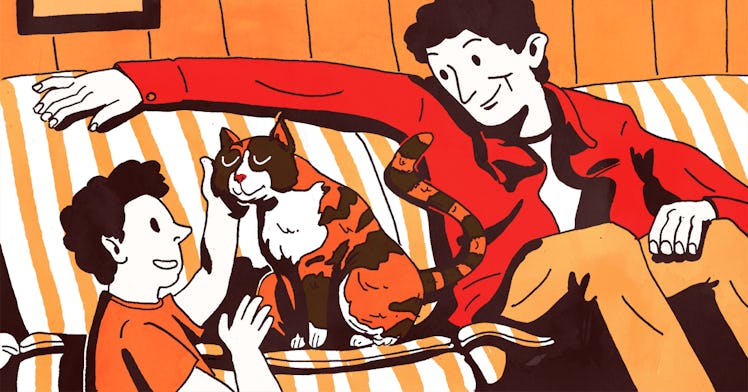How to Introduce Your Kid to a Cat (and Vice-Versa)
The potential of a positive feline-kid relationship is huge—but it won't happen by accident.

This story was produced in partnership with Arm & Hammer™ SLIDE™.
Whether you want to do a nice thing for an orphaned animal, give your kids some extra responsibility, or simply add an adorable companion to your household, there are lots of reasons to get a cat. But no matter why you’re adding a feline family member, you can’t just expect a perfect relationship to blossom naturally from day one.
Thankfully, there are a few simple things you can do to ensure that the kid-cat relationship gets off to a good start, that your cat settles into a comfortable life, and that you and your family reap the rewards of feline ownership. Here are a few of them.
Deploy proper petting technique.
Petting is the chief way humans show affection to their cats, so it’s crucial that everyone in your family does it right. Generally, cats prefer to be petted near their facial glands (ears, chin, and cheeks). The stomach and near the base of the tail, on the other hand, are areas that it’s best to avoid. It’s also important to leave the cat alone when they’re grooming, as one wants their hygienic routine interrupted.
Demonstrate proper petting technique to your kid when they first meet the cat, and supervise them until you’re confident they’ve got the hang of it. (And don’t forget to get a few scratches in yourself.)
Understand feline body language.
Until we have technology that translates “meow” into English, the best way to discern how your cat is doing is by understanding their body language. Purring, “making biscuits,” and seeking out affection through leg rubs and the like are all good signs. Any kinds of rapid movement, from a thrashing tail to rapid blinking, could be a sign of distress. Petting a freaked out cat is never a good idea, obviously, and understanding body language will vast decrease your kid’s chances of getting scratched.
Find the right toy.
Every cat is different. Some love catnip, some don’t care about it. Some are into chasing ribbons, which some like balls they can hit and chase around the house. There will be some trial and error in figuring out which toys your cat prefers, but the process of playing with the cat and trying to interpret their feelings is a great way for your kid to build an empathetic relationship with their feline companion.
Accept their quirks.
Some cats are super cuddly, and some mostly want to be left alone. Your kid might be disappointed if their cat is more of the latter at first, which is why it’s important to coach them through the lack of immediate gratification and ensure that your cat’s comfort stays top of mind. And given that you quite famously can’t really make a cat do anything, the path of least resistance—and most happiness—is in simply accepting that your cat is who your cat is.
Make cat care part of your kid’s routine.
Add feeding, watering, and/or scooping to your kid’s chore chart. The more your kids do to take care of the cat, the more responsibility they’ll build—and the less you’ll have to worry about.